MGBBT0FYP Research: Inflation Effects on Tourism & Solutions Explored
VerifiedAdded on 2023/06/05
|10
|2163
|487
Report
AI Summary
This report investigates the impacts of inflation on the tourism industry, focusing on the UK economy. It identifies both demand-pull and cost-push inflation and their effects on travel and tourism. The research includes quantitative analysis of inflation rates and consumer price indices, alongside qualitative insights into how inflation affects tourism businesses and consumer behavior. While moderate inflation can offer some benefits, such as allowing businesses to adjust wages and prices, the report highlights the negative impacts, including increased travel costs and decreased consumer spending on tourism. The study concludes with recommendations for tourism companies to mitigate these negative effects, such as absorbing key travel costs and offering value-added packages. Desklib offers more solved assignments and study resources for students.
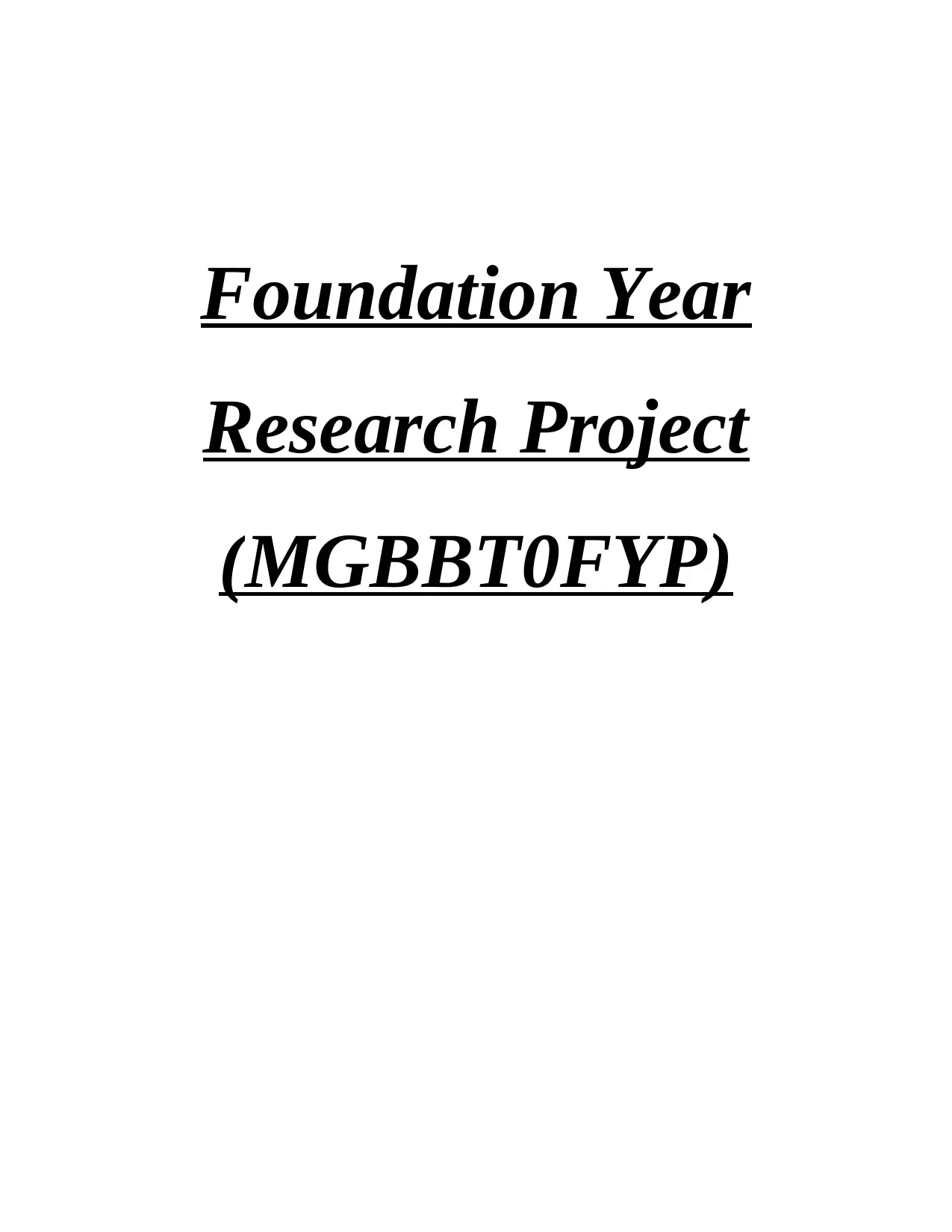
Foundation Year
Research Project
(MGBBT0FYP)
Research Project
(MGBBT0FYP)
Paraphrase This Document
Need a fresh take? Get an instant paraphrase of this document with our AI Paraphraser
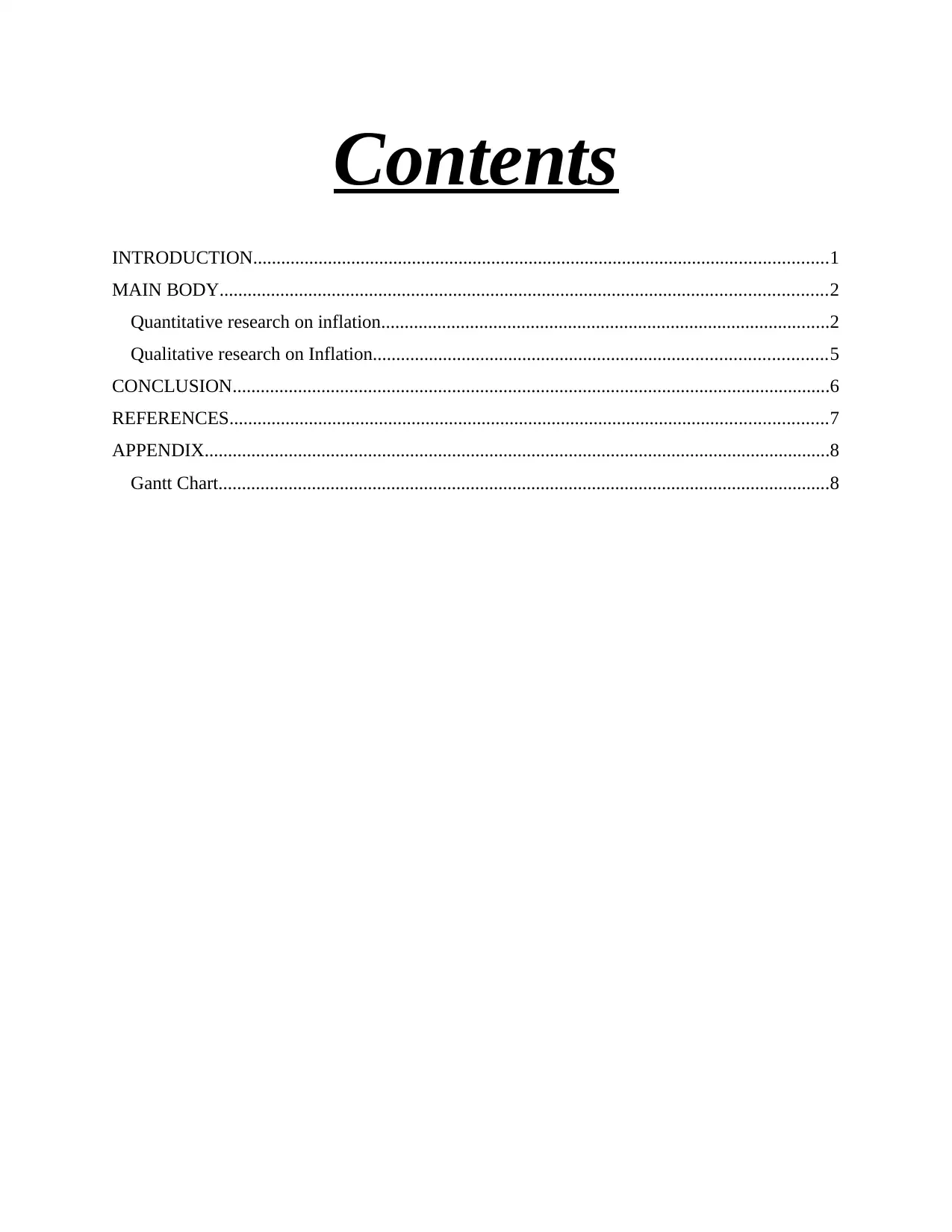
Contents
INTRODUCTION...........................................................................................................................1
MAIN BODY..................................................................................................................................2
Quantitative research on inflation................................................................................................2
Qualitative research on Inflation.................................................................................................5
CONCLUSION................................................................................................................................6
REFERENCES................................................................................................................................7
APPENDIX......................................................................................................................................8
Gantt Chart...................................................................................................................................8
INTRODUCTION...........................................................................................................................1
MAIN BODY..................................................................................................................................2
Quantitative research on inflation................................................................................................2
Qualitative research on Inflation.................................................................................................5
CONCLUSION................................................................................................................................6
REFERENCES................................................................................................................................7
APPENDIX......................................................................................................................................8
Gantt Chart...................................................................................................................................8
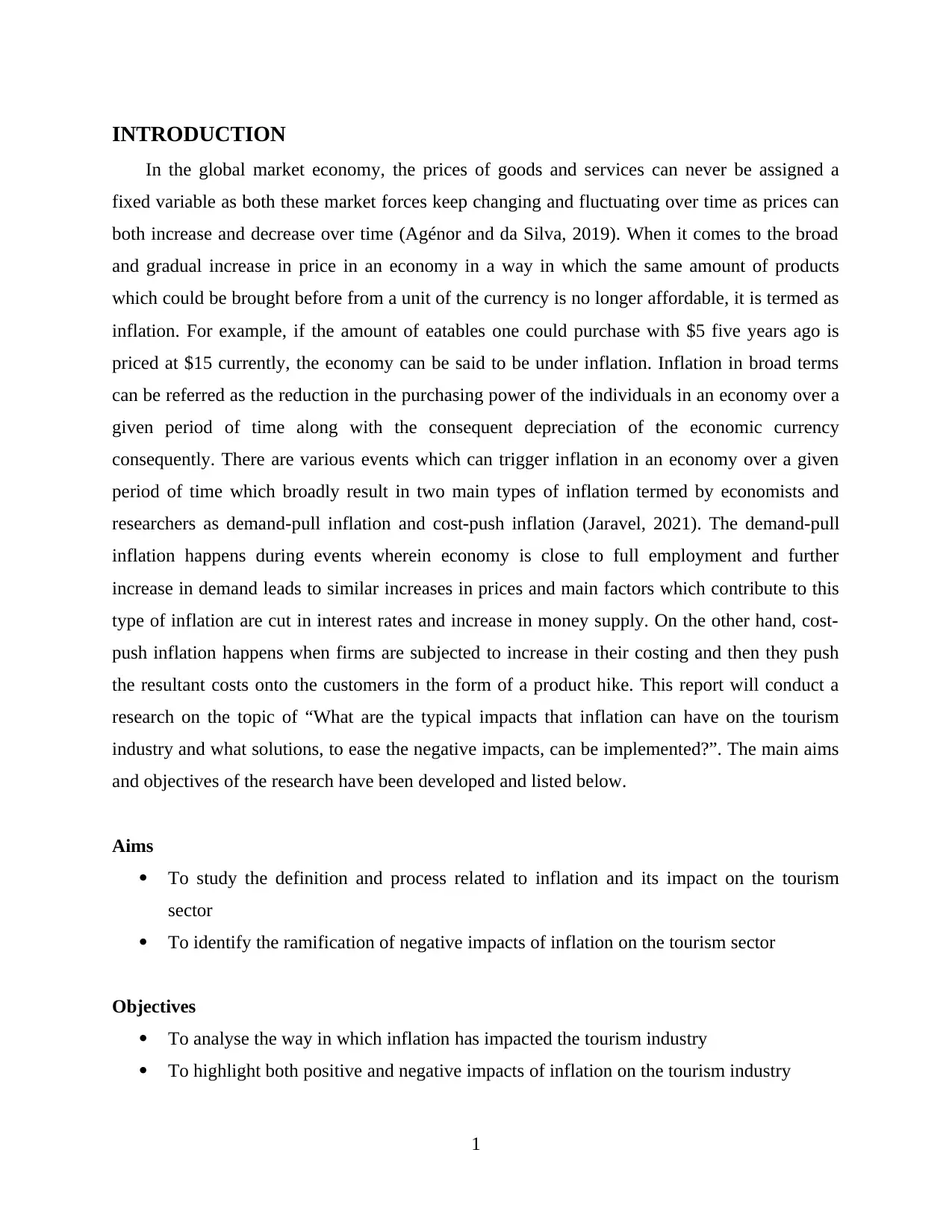
INTRODUCTION
In the global market economy, the prices of goods and services can never be assigned a
fixed variable as both these market forces keep changing and fluctuating over time as prices can
both increase and decrease over time (Agénor and da Silva, 2019). When it comes to the broad
and gradual increase in price in an economy in a way in which the same amount of products
which could be brought before from a unit of the currency is no longer affordable, it is termed as
inflation. For example, if the amount of eatables one could purchase with $5 five years ago is
priced at $15 currently, the economy can be said to be under inflation. Inflation in broad terms
can be referred as the reduction in the purchasing power of the individuals in an economy over a
given period of time along with the consequent depreciation of the economic currency
consequently. There are various events which can trigger inflation in an economy over a given
period of time which broadly result in two main types of inflation termed by economists and
researchers as demand-pull inflation and cost-push inflation (Jaravel, 2021). The demand-pull
inflation happens during events wherein economy is close to full employment and further
increase in demand leads to similar increases in prices and main factors which contribute to this
type of inflation are cut in interest rates and increase in money supply. On the other hand, cost-
push inflation happens when firms are subjected to increase in their costing and then they push
the resultant costs onto the customers in the form of a product hike. This report will conduct a
research on the topic of “What are the typical impacts that inflation can have on the tourism
industry and what solutions, to ease the negative impacts, can be implemented?”. The main aims
and objectives of the research have been developed and listed below.
Aims
To study the definition and process related to inflation and its impact on the tourism
sector
To identify the ramification of negative impacts of inflation on the tourism sector
Objectives
To analyse the way in which inflation has impacted the tourism industry
To highlight both positive and negative impacts of inflation on the tourism industry
1
In the global market economy, the prices of goods and services can never be assigned a
fixed variable as both these market forces keep changing and fluctuating over time as prices can
both increase and decrease over time (Agénor and da Silva, 2019). When it comes to the broad
and gradual increase in price in an economy in a way in which the same amount of products
which could be brought before from a unit of the currency is no longer affordable, it is termed as
inflation. For example, if the amount of eatables one could purchase with $5 five years ago is
priced at $15 currently, the economy can be said to be under inflation. Inflation in broad terms
can be referred as the reduction in the purchasing power of the individuals in an economy over a
given period of time along with the consequent depreciation of the economic currency
consequently. There are various events which can trigger inflation in an economy over a given
period of time which broadly result in two main types of inflation termed by economists and
researchers as demand-pull inflation and cost-push inflation (Jaravel, 2021). The demand-pull
inflation happens during events wherein economy is close to full employment and further
increase in demand leads to similar increases in prices and main factors which contribute to this
type of inflation are cut in interest rates and increase in money supply. On the other hand, cost-
push inflation happens when firms are subjected to increase in their costing and then they push
the resultant costs onto the customers in the form of a product hike. This report will conduct a
research on the topic of “What are the typical impacts that inflation can have on the tourism
industry and what solutions, to ease the negative impacts, can be implemented?”. The main aims
and objectives of the research have been developed and listed below.
Aims
To study the definition and process related to inflation and its impact on the tourism
sector
To identify the ramification of negative impacts of inflation on the tourism sector
Objectives
To analyse the way in which inflation has impacted the tourism industry
To highlight both positive and negative impacts of inflation on the tourism industry
1
⊘ This is a preview!⊘
Do you want full access?
Subscribe today to unlock all pages.

Trusted by 1+ million students worldwide
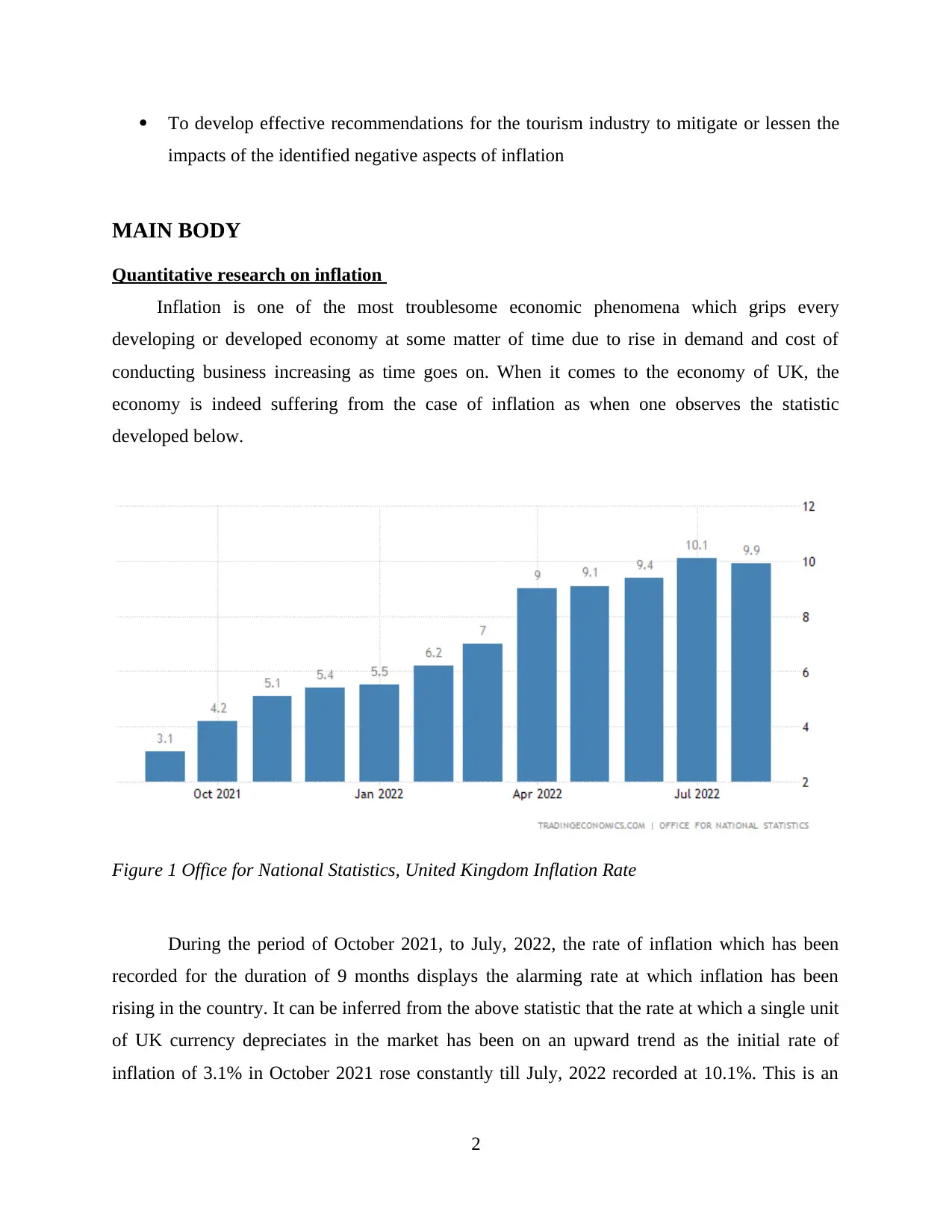
To develop effective recommendations for the tourism industry to mitigate or lessen the
impacts of the identified negative aspects of inflation
MAIN BODY
Quantitative research on inflation
Inflation is one of the most troublesome economic phenomena which grips every
developing or developed economy at some matter of time due to rise in demand and cost of
conducting business increasing as time goes on. When it comes to the economy of UK, the
economy is indeed suffering from the case of inflation as when one observes the statistic
developed below.
Figure 1 Office for National Statistics, United Kingdom Inflation Rate
During the period of October 2021, to July, 2022, the rate of inflation which has been
recorded for the duration of 9 months displays the alarming rate at which inflation has been
rising in the country. It can be inferred from the above statistic that the rate at which a single unit
of UK currency depreciates in the market has been on an upward trend as the initial rate of
inflation of 3.1% in October 2021 rose constantly till July, 2022 recorded at 10.1%. This is an
2
impacts of the identified negative aspects of inflation
MAIN BODY
Quantitative research on inflation
Inflation is one of the most troublesome economic phenomena which grips every
developing or developed economy at some matter of time due to rise in demand and cost of
conducting business increasing as time goes on. When it comes to the economy of UK, the
economy is indeed suffering from the case of inflation as when one observes the statistic
developed below.
Figure 1 Office for National Statistics, United Kingdom Inflation Rate
During the period of October 2021, to July, 2022, the rate of inflation which has been
recorded for the duration of 9 months displays the alarming rate at which inflation has been
rising in the country. It can be inferred from the above statistic that the rate at which a single unit
of UK currency depreciates in the market has been on an upward trend as the initial rate of
inflation of 3.1% in October 2021 rose constantly till July, 2022 recorded at 10.1%. This is an
2
Paraphrase This Document
Need a fresh take? Get an instant paraphrase of this document with our AI Paraphraser
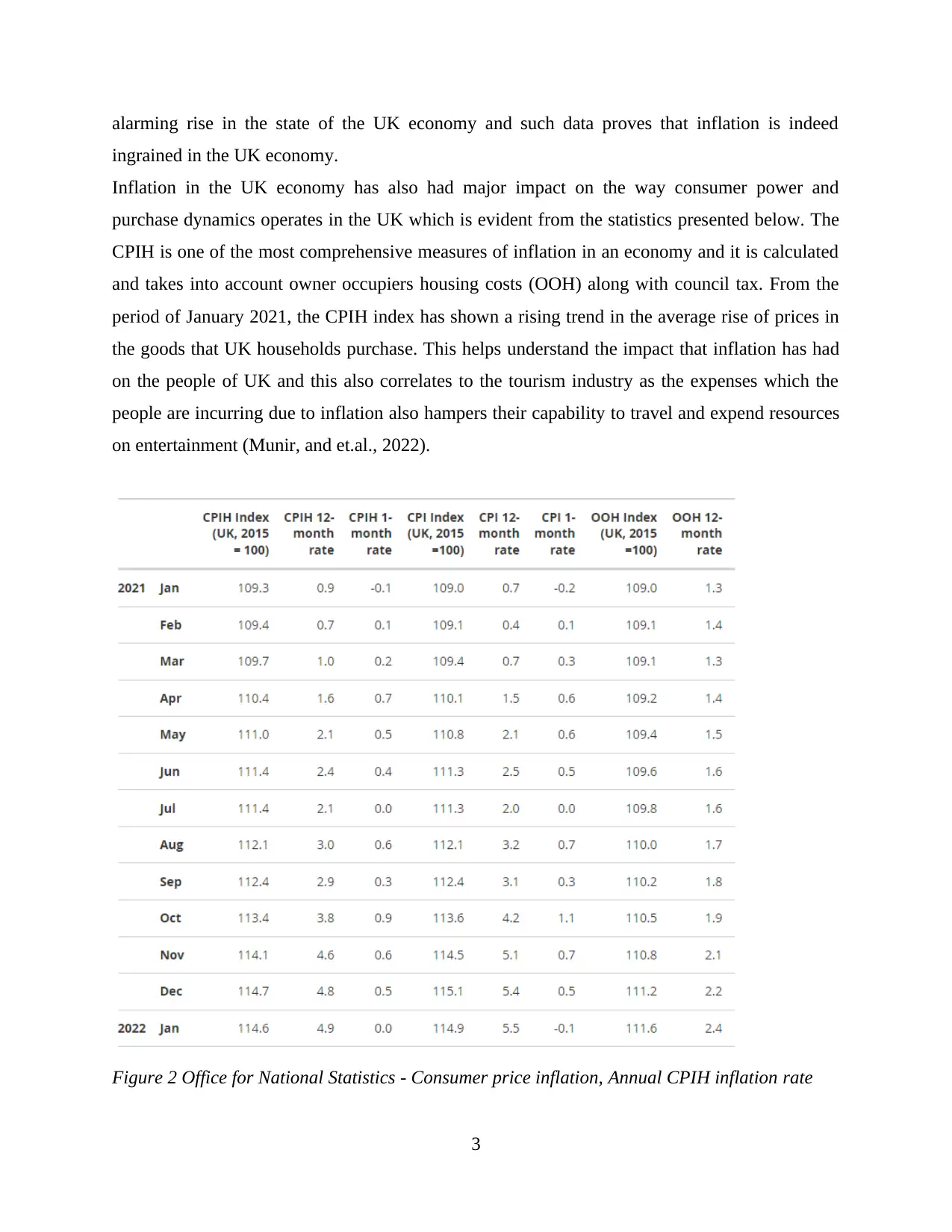
alarming rise in the state of the UK economy and such data proves that inflation is indeed
ingrained in the UK economy.
Inflation in the UK economy has also had major impact on the way consumer power and
purchase dynamics operates in the UK which is evident from the statistics presented below. The
CPIH is one of the most comprehensive measures of inflation in an economy and it is calculated
and takes into account owner occupiers housing costs (OOH) along with council tax. From the
period of January 2021, the CPIH index has shown a rising trend in the average rise of prices in
the goods that UK households purchase. This helps understand the impact that inflation has had
on the people of UK and this also correlates to the tourism industry as the expenses which the
people are incurring due to inflation also hampers their capability to travel and expend resources
on entertainment (Munir, and et.al., 2022).
Figure 2 Office for National Statistics - Consumer price inflation, Annual CPIH inflation rate
3
ingrained in the UK economy.
Inflation in the UK economy has also had major impact on the way consumer power and
purchase dynamics operates in the UK which is evident from the statistics presented below. The
CPIH is one of the most comprehensive measures of inflation in an economy and it is calculated
and takes into account owner occupiers housing costs (OOH) along with council tax. From the
period of January 2021, the CPIH index has shown a rising trend in the average rise of prices in
the goods that UK households purchase. This helps understand the impact that inflation has had
on the people of UK and this also correlates to the tourism industry as the expenses which the
people are incurring due to inflation also hampers their capability to travel and expend resources
on entertainment (Munir, and et.al., 2022).
Figure 2 Office for National Statistics - Consumer price inflation, Annual CPIH inflation rate
3
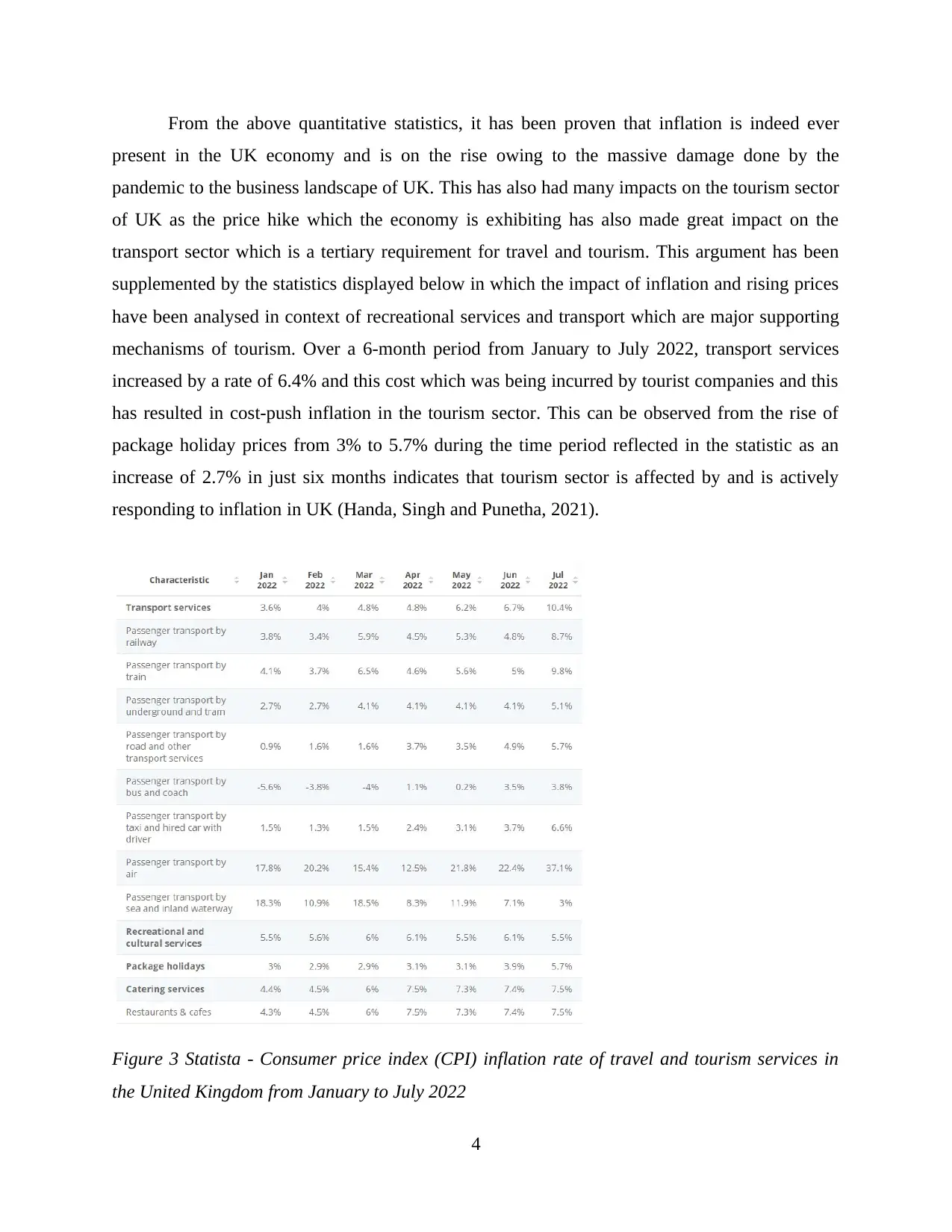
From the above quantitative statistics, it has been proven that inflation is indeed ever
present in the UK economy and is on the rise owing to the massive damage done by the
pandemic to the business landscape of UK. This has also had many impacts on the tourism sector
of UK as the price hike which the economy is exhibiting has also made great impact on the
transport sector which is a tertiary requirement for travel and tourism. This argument has been
supplemented by the statistics displayed below in which the impact of inflation and rising prices
have been analysed in context of recreational services and transport which are major supporting
mechanisms of tourism. Over a 6-month period from January to July 2022, transport services
increased by a rate of 6.4% and this cost which was being incurred by tourist companies and this
has resulted in cost-push inflation in the tourism sector. This can be observed from the rise of
package holiday prices from 3% to 5.7% during the time period reflected in the statistic as an
increase of 2.7% in just six months indicates that tourism sector is affected by and is actively
responding to inflation in UK (Handa, Singh and Punetha, 2021).
Figure 3 Statista - Consumer price index (CPI) inflation rate of travel and tourism services in
the United Kingdom from January to July 2022
4
present in the UK economy and is on the rise owing to the massive damage done by the
pandemic to the business landscape of UK. This has also had many impacts on the tourism sector
of UK as the price hike which the economy is exhibiting has also made great impact on the
transport sector which is a tertiary requirement for travel and tourism. This argument has been
supplemented by the statistics displayed below in which the impact of inflation and rising prices
have been analysed in context of recreational services and transport which are major supporting
mechanisms of tourism. Over a 6-month period from January to July 2022, transport services
increased by a rate of 6.4% and this cost which was being incurred by tourist companies and this
has resulted in cost-push inflation in the tourism sector. This can be observed from the rise of
package holiday prices from 3% to 5.7% during the time period reflected in the statistic as an
increase of 2.7% in just six months indicates that tourism sector is affected by and is actively
responding to inflation in UK (Handa, Singh and Punetha, 2021).
Figure 3 Statista - Consumer price index (CPI) inflation rate of travel and tourism services in
the United Kingdom from January to July 2022
4
⊘ This is a preview!⊘
Do you want full access?
Subscribe today to unlock all pages.

Trusted by 1+ million students worldwide
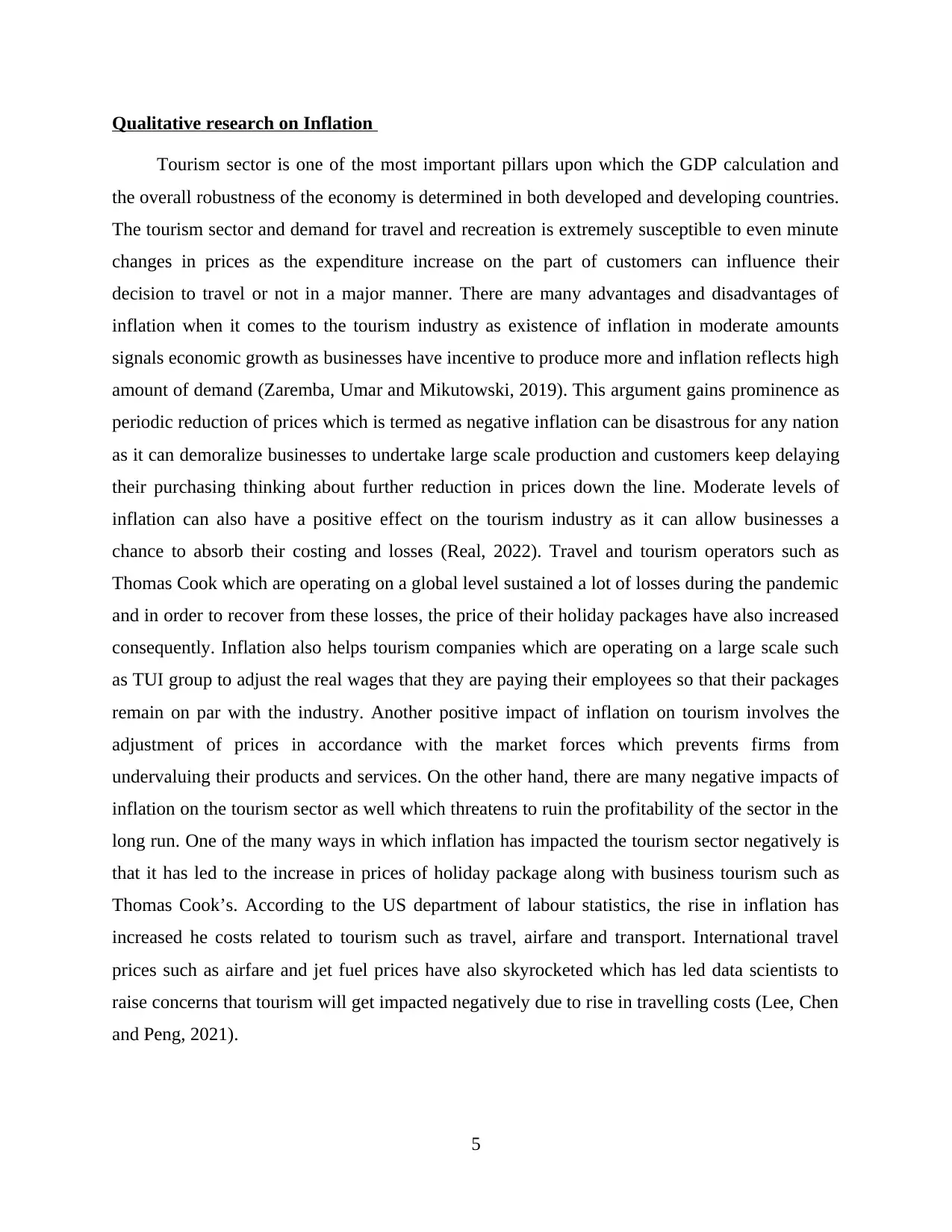
Qualitative research on Inflation
Tourism sector is one of the most important pillars upon which the GDP calculation and
the overall robustness of the economy is determined in both developed and developing countries.
The tourism sector and demand for travel and recreation is extremely susceptible to even minute
changes in prices as the expenditure increase on the part of customers can influence their
decision to travel or not in a major manner. There are many advantages and disadvantages of
inflation when it comes to the tourism industry as existence of inflation in moderate amounts
signals economic growth as businesses have incentive to produce more and inflation reflects high
amount of demand (Zaremba, Umar and Mikutowski, 2019). This argument gains prominence as
periodic reduction of prices which is termed as negative inflation can be disastrous for any nation
as it can demoralize businesses to undertake large scale production and customers keep delaying
their purchasing thinking about further reduction in prices down the line. Moderate levels of
inflation can also have a positive effect on the tourism industry as it can allow businesses a
chance to absorb their costing and losses (Real, 2022). Travel and tourism operators such as
Thomas Cook which are operating on a global level sustained a lot of losses during the pandemic
and in order to recover from these losses, the price of their holiday packages have also increased
consequently. Inflation also helps tourism companies which are operating on a large scale such
as TUI group to adjust the real wages that they are paying their employees so that their packages
remain on par with the industry. Another positive impact of inflation on tourism involves the
adjustment of prices in accordance with the market forces which prevents firms from
undervaluing their products and services. On the other hand, there are many negative impacts of
inflation on the tourism sector as well which threatens to ruin the profitability of the sector in the
long run. One of the many ways in which inflation has impacted the tourism sector negatively is
that it has led to the increase in prices of holiday package along with business tourism such as
Thomas Cook’s. According to the US department of labour statistics, the rise in inflation has
increased he costs related to tourism such as travel, airfare and transport. International travel
prices such as airfare and jet fuel prices have also skyrocketed which has led data scientists to
raise concerns that tourism will get impacted negatively due to rise in travelling costs (Lee, Chen
and Peng, 2021).
5
Tourism sector is one of the most important pillars upon which the GDP calculation and
the overall robustness of the economy is determined in both developed and developing countries.
The tourism sector and demand for travel and recreation is extremely susceptible to even minute
changes in prices as the expenditure increase on the part of customers can influence their
decision to travel or not in a major manner. There are many advantages and disadvantages of
inflation when it comes to the tourism industry as existence of inflation in moderate amounts
signals economic growth as businesses have incentive to produce more and inflation reflects high
amount of demand (Zaremba, Umar and Mikutowski, 2019). This argument gains prominence as
periodic reduction of prices which is termed as negative inflation can be disastrous for any nation
as it can demoralize businesses to undertake large scale production and customers keep delaying
their purchasing thinking about further reduction in prices down the line. Moderate levels of
inflation can also have a positive effect on the tourism industry as it can allow businesses a
chance to absorb their costing and losses (Real, 2022). Travel and tourism operators such as
Thomas Cook which are operating on a global level sustained a lot of losses during the pandemic
and in order to recover from these losses, the price of their holiday packages have also increased
consequently. Inflation also helps tourism companies which are operating on a large scale such
as TUI group to adjust the real wages that they are paying their employees so that their packages
remain on par with the industry. Another positive impact of inflation on tourism involves the
adjustment of prices in accordance with the market forces which prevents firms from
undervaluing their products and services. On the other hand, there are many negative impacts of
inflation on the tourism sector as well which threatens to ruin the profitability of the sector in the
long run. One of the many ways in which inflation has impacted the tourism sector negatively is
that it has led to the increase in prices of holiday package along with business tourism such as
Thomas Cook’s. According to the US department of labour statistics, the rise in inflation has
increased he costs related to tourism such as travel, airfare and transport. International travel
prices such as airfare and jet fuel prices have also skyrocketed which has led data scientists to
raise concerns that tourism will get impacted negatively due to rise in travelling costs (Lee, Chen
and Peng, 2021).
5
Paraphrase This Document
Need a fresh take? Get an instant paraphrase of this document with our AI Paraphraser
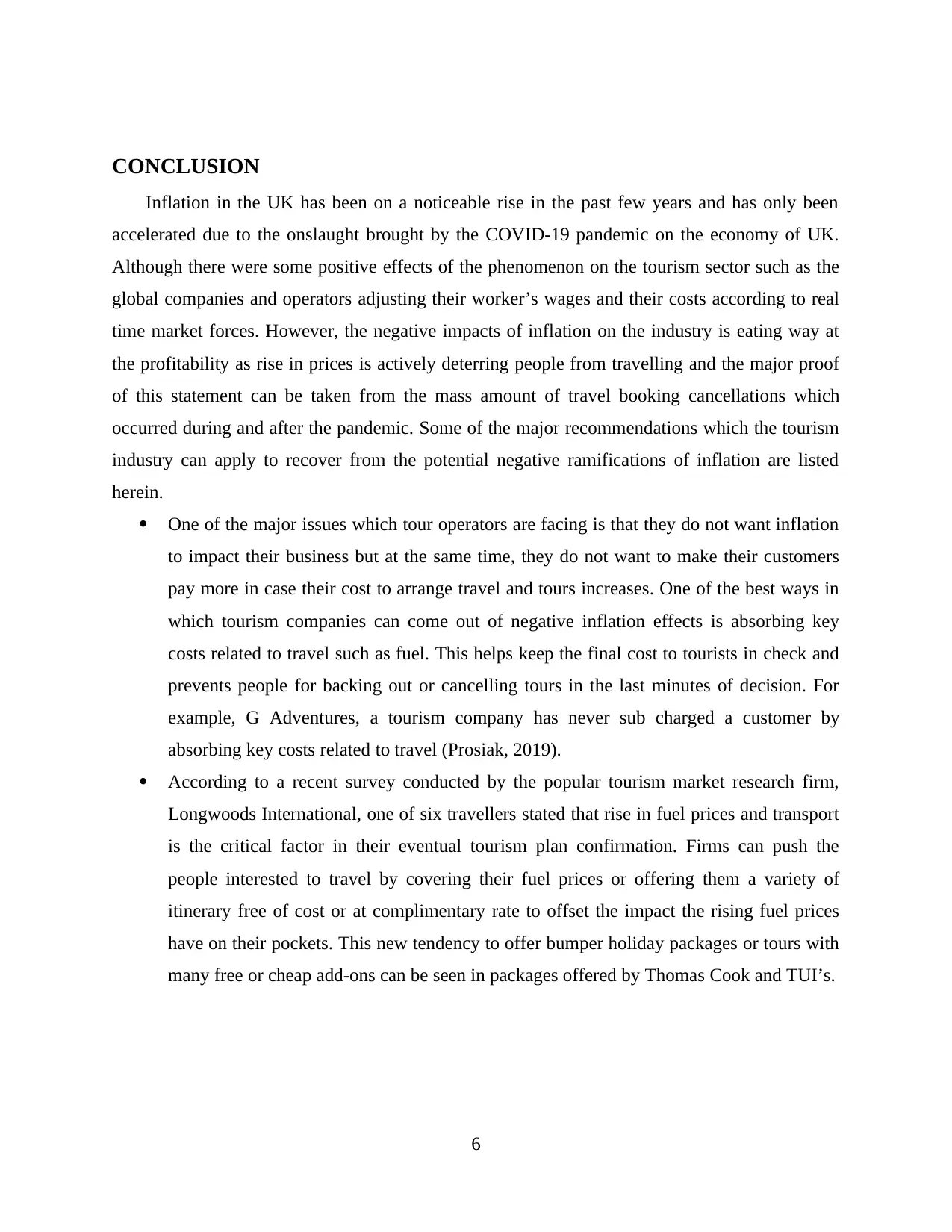
CONCLUSION
Inflation in the UK has been on a noticeable rise in the past few years and has only been
accelerated due to the onslaught brought by the COVID-19 pandemic on the economy of UK.
Although there were some positive effects of the phenomenon on the tourism sector such as the
global companies and operators adjusting their worker’s wages and their costs according to real
time market forces. However, the negative impacts of inflation on the industry is eating way at
the profitability as rise in prices is actively deterring people from travelling and the major proof
of this statement can be taken from the mass amount of travel booking cancellations which
occurred during and after the pandemic. Some of the major recommendations which the tourism
industry can apply to recover from the potential negative ramifications of inflation are listed
herein.
One of the major issues which tour operators are facing is that they do not want inflation
to impact their business but at the same time, they do not want to make their customers
pay more in case their cost to arrange travel and tours increases. One of the best ways in
which tourism companies can come out of negative inflation effects is absorbing key
costs related to travel such as fuel. This helps keep the final cost to tourists in check and
prevents people for backing out or cancelling tours in the last minutes of decision. For
example, G Adventures, a tourism company has never sub charged a customer by
absorbing key costs related to travel (Prosiak, 2019).
According to a recent survey conducted by the popular tourism market research firm,
Longwoods International, one of six travellers stated that rise in fuel prices and transport
is the critical factor in their eventual tourism plan confirmation. Firms can push the
people interested to travel by covering their fuel prices or offering them a variety of
itinerary free of cost or at complimentary rate to offset the impact the rising fuel prices
have on their pockets. This new tendency to offer bumper holiday packages or tours with
many free or cheap add-ons can be seen in packages offered by Thomas Cook and TUI’s.
6
Inflation in the UK has been on a noticeable rise in the past few years and has only been
accelerated due to the onslaught brought by the COVID-19 pandemic on the economy of UK.
Although there were some positive effects of the phenomenon on the tourism sector such as the
global companies and operators adjusting their worker’s wages and their costs according to real
time market forces. However, the negative impacts of inflation on the industry is eating way at
the profitability as rise in prices is actively deterring people from travelling and the major proof
of this statement can be taken from the mass amount of travel booking cancellations which
occurred during and after the pandemic. Some of the major recommendations which the tourism
industry can apply to recover from the potential negative ramifications of inflation are listed
herein.
One of the major issues which tour operators are facing is that they do not want inflation
to impact their business but at the same time, they do not want to make their customers
pay more in case their cost to arrange travel and tours increases. One of the best ways in
which tourism companies can come out of negative inflation effects is absorbing key
costs related to travel such as fuel. This helps keep the final cost to tourists in check and
prevents people for backing out or cancelling tours in the last minutes of decision. For
example, G Adventures, a tourism company has never sub charged a customer by
absorbing key costs related to travel (Prosiak, 2019).
According to a recent survey conducted by the popular tourism market research firm,
Longwoods International, one of six travellers stated that rise in fuel prices and transport
is the critical factor in their eventual tourism plan confirmation. Firms can push the
people interested to travel by covering their fuel prices or offering them a variety of
itinerary free of cost or at complimentary rate to offset the impact the rising fuel prices
have on their pockets. This new tendency to offer bumper holiday packages or tours with
many free or cheap add-ons can be seen in packages offered by Thomas Cook and TUI’s.
6
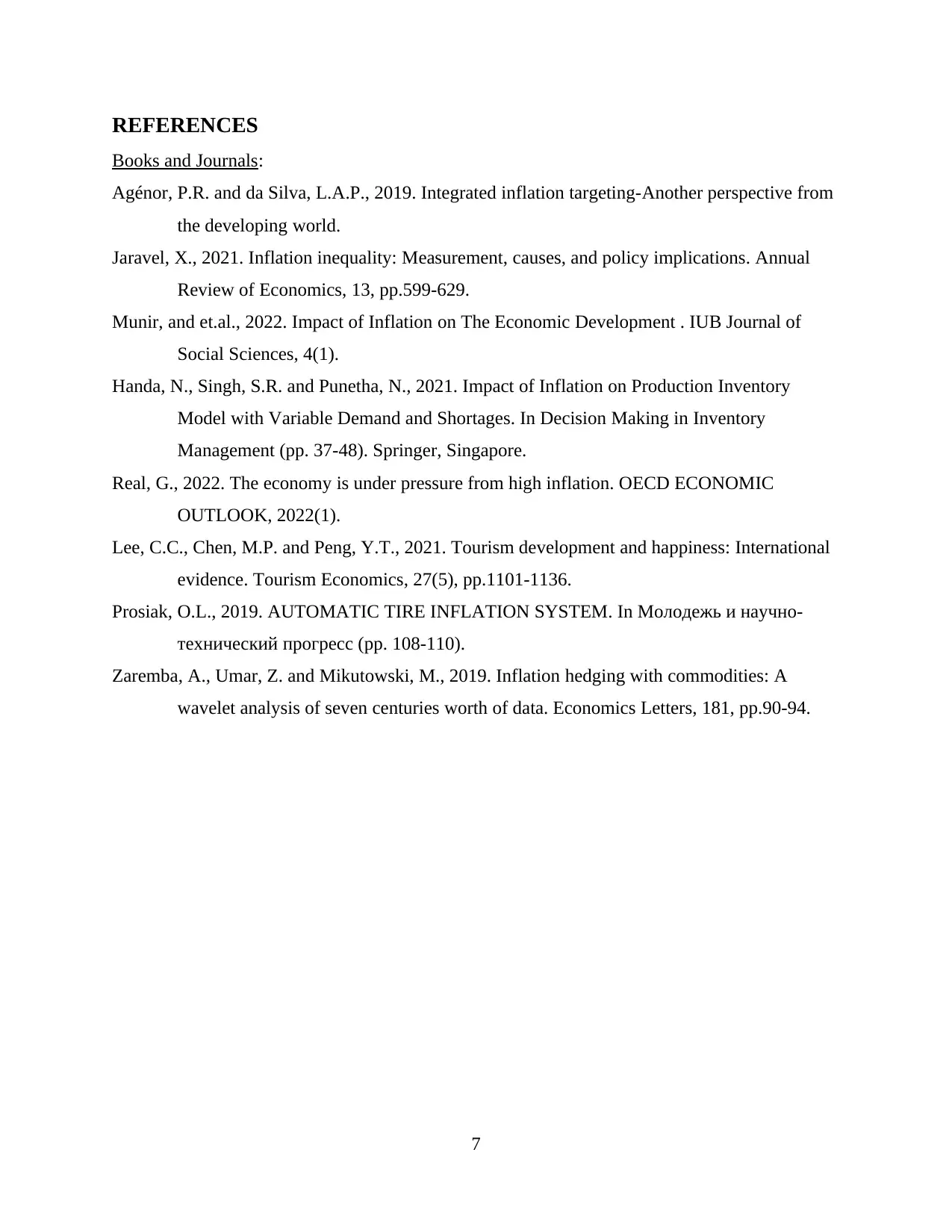
REFERENCES
Books and Journals:
Agénor, P.R. and da Silva, L.A.P., 2019. Integrated inflation targeting-Another perspective from
the developing world.
Jaravel, X., 2021. Inflation inequality: Measurement, causes, and policy implications. Annual
Review of Economics, 13, pp.599-629.
Munir, and et.al., 2022. Impact of Inflation on The Economic Development . IUB Journal of
Social Sciences, 4(1).
Handa, N., Singh, S.R. and Punetha, N., 2021. Impact of Inflation on Production Inventory
Model with Variable Demand and Shortages. In Decision Making in Inventory
Management (pp. 37-48). Springer, Singapore.
Real, G., 2022. The economy is under pressure from high inflation. OECD ECONOMIC
OUTLOOK, 2022(1).
Lee, C.C., Chen, M.P. and Peng, Y.T., 2021. Tourism development and happiness: International
evidence. Tourism Economics, 27(5), pp.1101-1136.
Prosiak, O.L., 2019. AUTOMATIC TIRE INFLATION SYSTEM. In Молодежь и научно-
технический прогресс (pp. 108-110).
Zaremba, A., Umar, Z. and Mikutowski, M., 2019. Inflation hedging with commodities: A
wavelet analysis of seven centuries worth of data. Economics Letters, 181, pp.90-94.
7
Books and Journals:
Agénor, P.R. and da Silva, L.A.P., 2019. Integrated inflation targeting-Another perspective from
the developing world.
Jaravel, X., 2021. Inflation inequality: Measurement, causes, and policy implications. Annual
Review of Economics, 13, pp.599-629.
Munir, and et.al., 2022. Impact of Inflation on The Economic Development . IUB Journal of
Social Sciences, 4(1).
Handa, N., Singh, S.R. and Punetha, N., 2021. Impact of Inflation on Production Inventory
Model with Variable Demand and Shortages. In Decision Making in Inventory
Management (pp. 37-48). Springer, Singapore.
Real, G., 2022. The economy is under pressure from high inflation. OECD ECONOMIC
OUTLOOK, 2022(1).
Lee, C.C., Chen, M.P. and Peng, Y.T., 2021. Tourism development and happiness: International
evidence. Tourism Economics, 27(5), pp.1101-1136.
Prosiak, O.L., 2019. AUTOMATIC TIRE INFLATION SYSTEM. In Молодежь и научно-
технический прогресс (pp. 108-110).
Zaremba, A., Umar, Z. and Mikutowski, M., 2019. Inflation hedging with commodities: A
wavelet analysis of seven centuries worth of data. Economics Letters, 181, pp.90-94.
7
⊘ This is a preview!⊘
Do you want full access?
Subscribe today to unlock all pages.

Trusted by 1+ million students worldwide
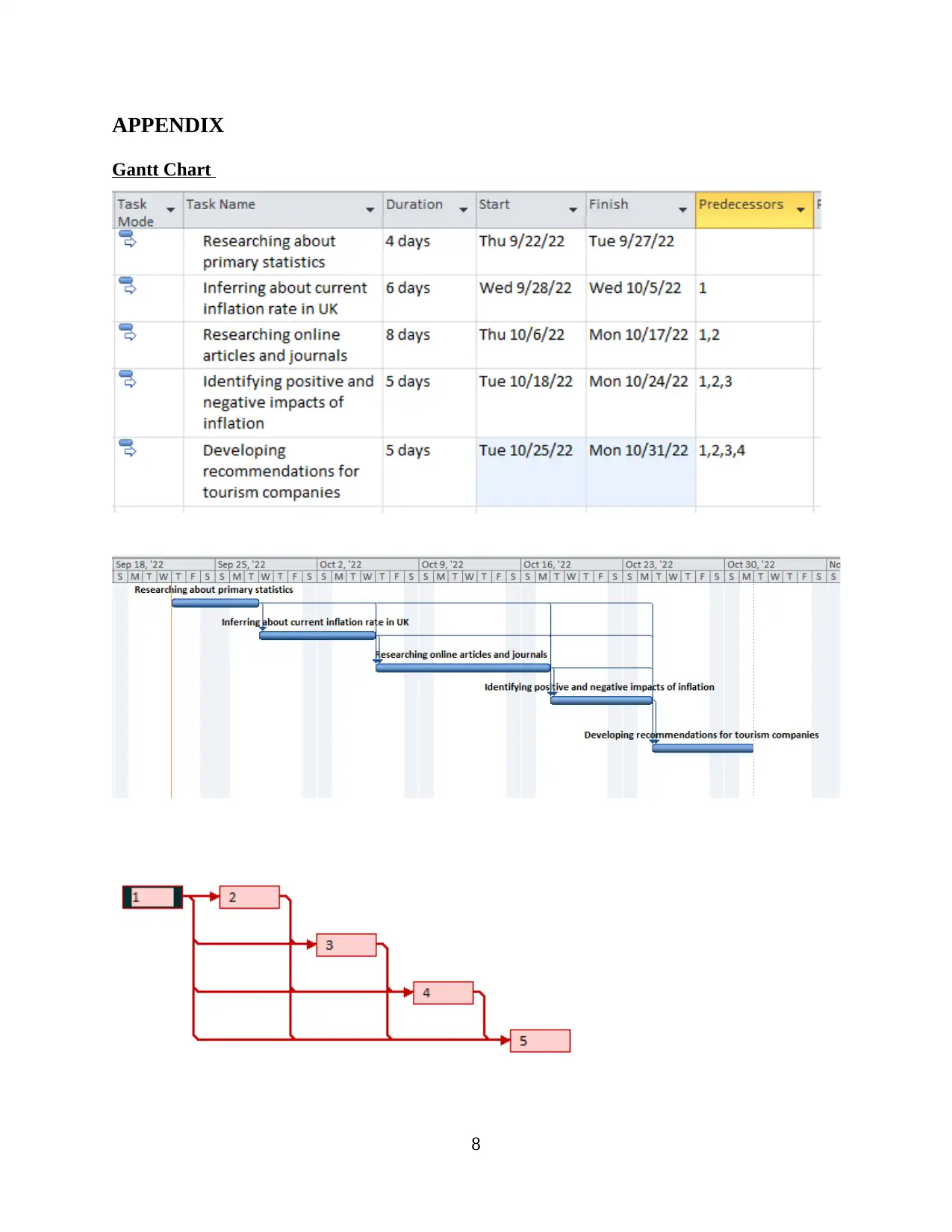
APPENDIX
Gantt Chart
8
Gantt Chart
8
1 out of 10
Related Documents
Your All-in-One AI-Powered Toolkit for Academic Success.
+13062052269
info@desklib.com
Available 24*7 on WhatsApp / Email
![[object Object]](/_next/static/media/star-bottom.7253800d.svg)
Unlock your academic potential
Copyright © 2020–2025 A2Z Services. All Rights Reserved. Developed and managed by ZUCOL.


